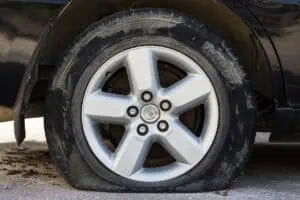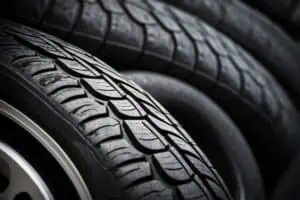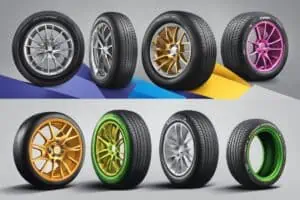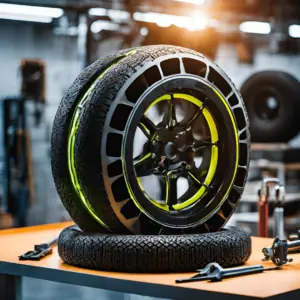Tires are one of our thankful heroes of our daily commutes and weekend adventures. The smoother the ride, the healthier the tires. But have you ever wondered about the secret to their longevity? It’s timely tire rotation.
Understanding Tire Rotation
In its essence, tire rotation is shuffling your vehicle’s tires from one position to another to ensure even wear. It’s like playing musical chairs, but for your car’s rubber companions. Why is this necessary? Uneven wear is a sneaky issue that arises due to various factors, such as alignment discrepancies, weight distribution, and the myriad of driving conditions we expose our tires to. Think about it: the front tires, for instance, bear the brunt when you brake. Over time, this uneven burden takes its toll.
Key Benefits of Regular Tire Rotation
Extended tire lifespan: Ever dream of hitting the 100,000-mile mark with the same set of tires? Regular rotations make this a tangible reality, enhancing your tire’s lifespan by ensuring even wear.
Improved gas mileage: A well-maintained tire reduces the effort your engine expends, translating to better mileage. That’s more road trips on less fuel!
Better and safer vehicle handling: With each tire wearing out evenly, your vehicle rewards you with predictable and smooth handling, even in those surprise rain showers.
Consistent performance: No more sudden brakes or skidding when you least expect it. Regular tire rotations make for a drive as smooth as a jazz tune, thanks to the more even tire wear.
Factors Influencing Tire Rotation Frequency
Now, before you mark your calendar for a tire rotation every month, let’s dive into what dictates the frequency.
Vehicle Type: It’s essential to note that not all vehicles dance to the same tune. Front-wheel drives, rear-wheel drives, and all-wheel drives all have their own unique wear patterns. For instance, the front tires in a front-wheel drive bear more weight and wear out faster. Knowing your vehicle type helps in devising the ideal rotation strategy.
Tire Type: Did you know that performance tires and all-season tires wear out differently? Winter tires, tailored for colder climes, and off-road tires, perfect for that mountainous adventure, also have their distinct wear patterns. Knowledge is power, and knowing your tire type is the first step in preventive care.
Driving Conditions: Cruising down urban streets is a whole different ballgame compared to navigating rugged terrains. Urban driving, with its stop-and-go traffic, might wear out your tires differently than long, uninterrupted drives in the countryside.
Driving Habits: It’s all fun and games until aggressive driving and sudden brakes wear out your tires prematurely. The softer your driving habits, the longer your tires last. However, if you find thrill in sharp turns and quick halts, keep an eye out for faster wear.
General Guidelines on Tire Rotation Frequency
With so many variables in play, how often should you rotate your tires? Here’s the golden nugget: while it’s wise to heed the manufacturer’s recommendations, a good rule of thumb is to consider tire rotation every 6,000 to 8,000 miles. And for those juggling between summer breezes and winter chills, rotating tires seasonally, especially if you switch between summer and winter tires, ensures you’re always at peak performance.
Signs That Indicate It’s Time for a Tire Rotation
Awareness is pivotal. Being in tune with your vehicle’s cues can spell the difference between a serene journey and an abrupt halt on the freeway. Here are some of the tell-tale signs your tires are subtly whispering, “It’s time”:
Uneven tire wear: This is the most evident sign. If you spot irregular patterns like cupping or feathering on your tire treads, it’s a clarion call.
Vibrations: Feeling your car humming a bit too much, especially around the 45 to 60 mph mark? That’s not your vehicle breaking into a song but possibly a sign of uneven tire wear.
Decreased fuel efficiency: If you suddenly find yourself visiting the gas station a tad too often, your tires might be the culprit. Uneven wear increases rolling resistance, making your engine work overtime.
A drop in performance: If your car seems to be struggling with corners or takes longer to brake, it’s likely signaling a check on tire health.
Steps to Properly Rotate Tires
So, you’ve decided to give your tires a fresh perspective? Great choice! Here’s how to ensure you’re doing it right:
- Spot the Pattern: Different vehicles have different tire rotation patterns. Whether it’s the cross-rotation, front-to-back, or another pattern, always consult your vehicle’s manual to identify the right one.
- Pressure Check: After the rotation, ensure all tires are inflated to the recommended pressure. It not only ensures safety but also boosts the efficiency of your drive.
- Stay Organized: Maintaining a rotation log can be a game-changer. By jotting down details every time you rotate, you’ll always be in the know, preventing undue wear and potential hazards.
Professional vs. DIY Tire Rotation
The aroma of DIY projects is irresistible for many. But should tire rotation be on that list?
Benefits of Professional Touch: Taking your vehicle to a pro means more than just tire rotation. They bring expertise to the table, checking for alignment issues and other potential problems, ensuring a comprehensive health check for your tires.
Going the DIY Route: If you’re confident about rotating your tires at home, make sure you’re well-equipped. Having the right tools and knowledge about the rotation pattern for your vehicle type is crucial. And remember, safety first!
Addressing Common Myths and Misconceptions
Let’s bust some myths, shall we?
- – “No visible wear means no rotation needed.” False! Even if wear isn’t immediately visible, internal damages can still occur. Regular rotations can preempt many such issues.
- – “Every vehicle follows the same rotation strategy.” Quite the contrary! Depending on whether you have a front-wheel, rear-wheel, or all-wheel drive, the rotation pattern changes.
- – “Tire rotation is solely about moving tires around.” Think bigger! It’s about maintenance, prolonging tire life, and ensuring a safe and smooth drive.
Conclusion
Tire rotation might seem like a trivial chore, but its implications on vehicle performance, safety, and maintenance are paramount. Like how regular workouts keep us in prime shape, regular tire rotations ensure our vehicles are always road-ready, efficient, and safe. So, the next time you hit that 6,000-mile mark, give a thought to those trusty tires beneath you. They might just be due for a well-deserved shuffle!
Drive safe, and always keep those tires in check!





























